Saint Mary Magdalene Exhibit In Kawit Cavite
 Before attending the concelebrated mass in Saint Mary Magdalene Parish for the Feast of the Mary Magdalene, I already made an inquiry to admin of their official Facebook page regarding to their ecclesiastical exhibit. I asked them what happened to those old memorabilla that they used to display on the church. I saw a couple of items before so I’m pretty sure they transferred it somewhere. They told me that they decided to put all the historical items in an exhibit and is now situated on a convent. The exhibit is open publicly but since we arrived there during a very special day, the convent was closed and we were advised to visit the following days. The exhibit is open every Tuesdays to Sundays.
Before attending the concelebrated mass in Saint Mary Magdalene Parish for the Feast of the Mary Magdalene, I already made an inquiry to admin of their official Facebook page regarding to their ecclesiastical exhibit. I asked them what happened to those old memorabilla that they used to display on the church. I saw a couple of items before so I’m pretty sure they transferred it somewhere. They told me that they decided to put all the historical items in an exhibit and is now situated on a convent. The exhibit is open publicly but since we arrived there during a very special day, the convent was closed and we were advised to visit the following days. The exhibit is open every Tuesdays to Sundays.  The Saint Mary Magdalene Church. Interestingly, you can reach the exhibit in two possible ways. You can enter the Saint Mary Magdalene Elementary school and just inform the guard and they will guide you to that particular room or if the door from that face is close, you can approach the other way by heading towards the convent, the way that only priests and other authorized person can enter. You may ask a permission directly to their main office and they will ask someone to guide you.
The Saint Mary Magdalene Church. Interestingly, you can reach the exhibit in two possible ways. You can enter the Saint Mary Magdalene Elementary school and just inform the guard and they will guide you to that particular room or if the door from that face is close, you can approach the other way by heading towards the convent, the way that only priests and other authorized person can enter. You may ask a permission directly to their main office and they will ask someone to guide you.  A view of the St Mary Magdalene Elementary School from the rear portion of the church (it’s the one facing the main road).
A view of the St Mary Magdalene Elementary School from the rear portion of the church (it’s the one facing the main road).  The right side of the church and the way towards the main office and the convent which is situated within the school.
The right side of the church and the way towards the main office and the convent which is situated within the school.
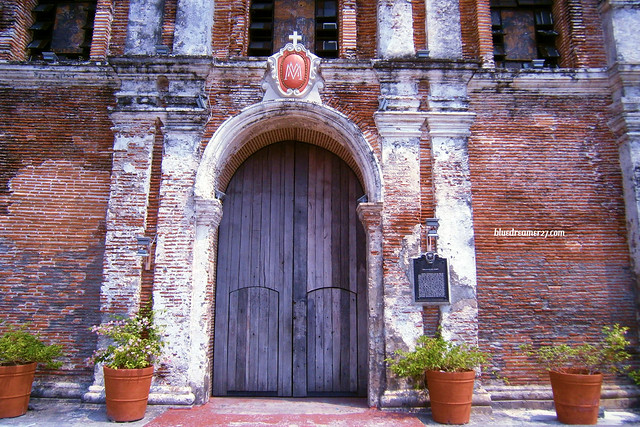 The wooden front door of the centuries-old church
The wooden front door of the centuries-old church 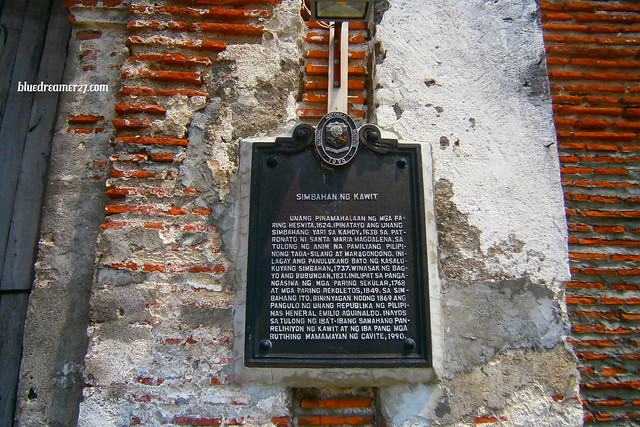 A historical marker.
A historical marker.
 It is a very simple exhibit located on a modified class room. A small portion of the room also serves as the convent’s kitchen. The exhibit displays both ecclesiastical items related to Saint Mary Magdalene and also some notable historical memorabilia in relation with Emilio Aguinaldo, the first president of the country.
It is a very simple exhibit located on a modified class room. A small portion of the room also serves as the convent’s kitchen. The exhibit displays both ecclesiastical items related to Saint Mary Magdalene and also some notable historical memorabilia in relation with Emilio Aguinaldo, the first president of the country.  The first thing you’ll notice once you enter the exhibit are the life-size statues depicting different images of Mary Magdalene. This one depicts the “repentance of Mary Magdalene”
The first thing you’ll notice once you enter the exhibit are the life-size statues depicting different images of Mary Magdalene. This one depicts the “repentance of Mary Magdalene”


 Mary Magdalene at the Crucifixion (commonly describe as Women at the Crucifixion as she was accompanied by Mary and her sister Mary the wife of Clopas)
Mary Magdalene at the Crucifixion (commonly describe as Women at the Crucifixion as she was accompanied by Mary and her sister Mary the wife of Clopas)  Mary Magdalene at the empty tomb
Mary Magdalene at the empty tomb

 Mary Magdalane in the resurrection of Jesus. Mary Magdalene was the first person to ever witness the resurrected Jesus!
Mary Magdalane in the resurrection of Jesus. Mary Magdalene was the first person to ever witness the resurrected Jesus!
 On the other side of the wall lies some old books and pictures showing the early image of Mary Magdalene, the old Church and some historical memorabilia about Emilio Aguinaldo.
On the other side of the wall lies some old books and pictures showing the early image of Mary Magdalene, the old Church and some historical memorabilia about Emilio Aguinaldo. 
 A 1930 picture showcasing the old belfry of the parish
A 1930 picture showcasing the old belfry of the parish  During my recent trip to Aguinaldo Shrine, we have learned that Emilio Aguinaldo was baptized in Mary Magdalene Parish and interestingly, the church was able to save the original copy of Emilio Aguinaldo’s Baptismal records.
During my recent trip to Aguinaldo Shrine, we have learned that Emilio Aguinaldo was baptized in Mary Magdalene Parish and interestingly, the church was able to save the original copy of Emilio Aguinaldo’s Baptismal records.  This must be a Vulgate, a Latin version of the Bible which emerged during the late fourth-century and is mostly attributed to St Jerome.
This must be a Vulgate, a Latin version of the Bible which emerged during the late fourth-century and is mostly attributed to St Jerome.  Not sure about this one but since it has some noticeable computations, this book must be an old accounting records of the church.
Not sure about this one but since it has some noticeable computations, this book must be an old accounting records of the church.  Baptismal Records since 1830! Wow!
Baptismal Records since 1830! Wow!  The former parish priests.
The former parish priests. 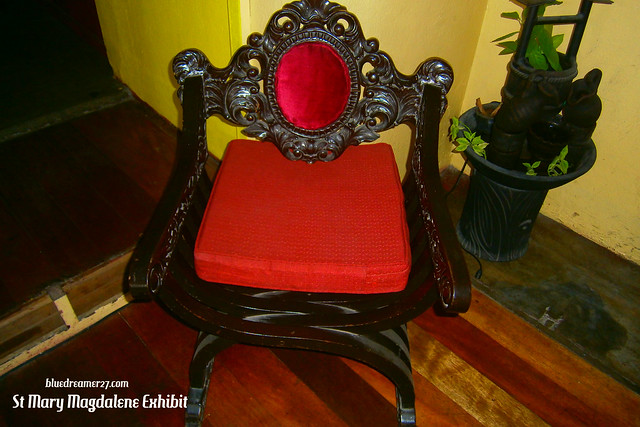 Check out this old furniture!
Check out this old furniture!  Candle holders
Candle holders 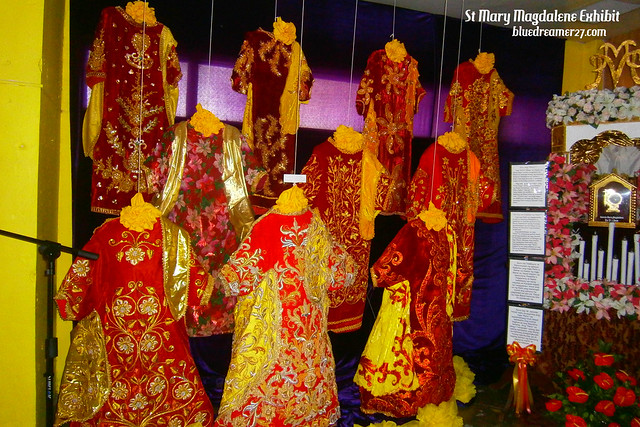 The highlights of the exhibit are not just the life-size images nor those old books and records but the relics and other items used for the image of Mary Magdalene for the past centuries. Here, you’ll find the old dresses used for the image for the past years. Again, the image is notably aromatic which means you can smell the fragrance from these dresses even from afar.
The highlights of the exhibit are not just the life-size images nor those old books and records but the relics and other items used for the image of Mary Magdalene for the past centuries. Here, you’ll find the old dresses used for the image for the past years. Again, the image is notably aromatic which means you can smell the fragrance from these dresses even from afar.  A relic from Mary Magdalene
A relic from Mary Magdalene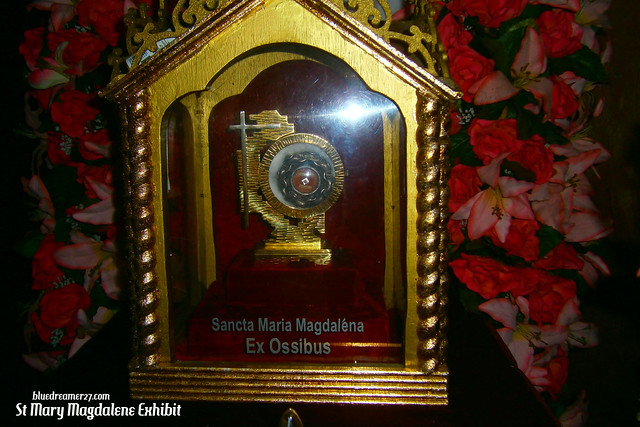 This must be a first class relic knowing that it has the term “Ex Ossibus” which means “From the bones”.
This must be a first class relic knowing that it has the term “Ex Ossibus” which means “From the bones”.  A pair of dresses used in 1930 and 1940 respectively.
A pair of dresses used in 1930 and 1940 respectively.  One of the most interesting highlights of the exhibit aside from the old dresses and relics are these shiny jewelries.
One of the most interesting highlights of the exhibit aside from the old dresses and relics are these shiny jewelries. 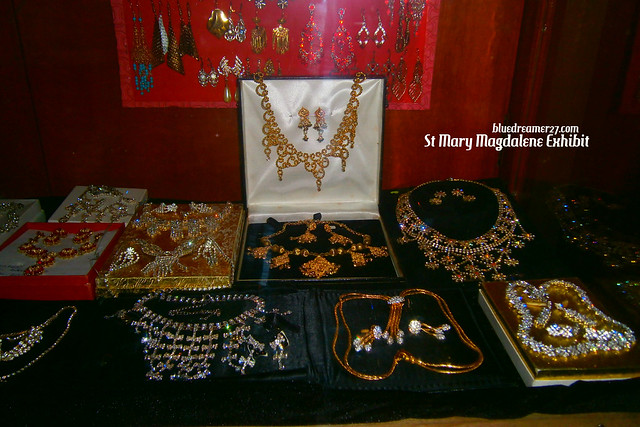
 Necklaces and earrings used for the image of Mary Magdalene for the past decades.
Necklaces and earrings used for the image of Mary Magdalene for the past decades.  Crowns and tiaras.
Crowns and tiaras.  Mary Magdalene has many attributes and this vessel of ointment is one of her commonly used symbols or attributes.
Mary Magdalene has many attributes and this vessel of ointment is one of her commonly used symbols or attributes.  Cross, also a symbol of Saint Mary Magdalene.
Cross, also a symbol of Saint Mary Magdalene.
I learned a lot from this exhibit and I’m not sure if this exhibit is only for a limited time but I hope not. I also wish that they can build a separate building to display these historical items much like what they did in Sta Cruz Convent Museum.



The building looks like it have a lot of flooring and walls from wood. Hopefully they have good fire prevention method. Kinda scary to see all these historical items stored there if there is no proper fire measures.
I didn’t know that that’s how the vessel of ointment looks like to symbolize Mary Magdalene. How is it related to her character? The wooden front door is a nice place for a fashion photo shoot. 🙂
the life-size images are indeed very beautifully done, each has very realistic emotions on the face and truly tells the story behind, also the costumes are seriously tailored and very much detailed, one word says it all – impressive!!
besides the images, the books and artefacts are also very impressive too, so well kept and still in good conditions.. and lastly, of course are those relics and items used on the images, kept since decades ago, this place is really full of treasure.. 🙂
It’s nice to see that there is a shrine for Mary Magdalene. She does represent have a lot of importance to the story of Christ and forgiveness and humility.
The life-sized statues are amazing! I wish I could visit that place and take a closer look at the costumes.
I am sure that this exhibition is so solemn and would LOVE to visit it one day.
[This must be a Vulgate, a Latin version of the Bible which emerged during the late fourth-century and is mostly attributed to St Jerome. ]
Actually, the book you are referring to is not a copy of the Vulgate; It is an old Missal which contains the old order of the Mass (which was said mostly in Latin) before the reforms of Vatican II. In the picture, you can see the Missal is opened at the pages where the prayers that the priest should say before he takes and while he is taking the Body and Blood of Christ prior to the distribution of Holy Communion to the people are contained. The black large texts are the prayers, while the red small texts are the instructions/rubrics which dictate the priest’s every movement or posture.
Anyway, thank you for visiting our province 😀
Yay.. thanks for the details.. I will edit this post right away!